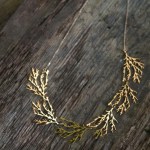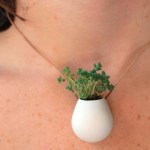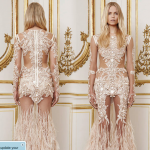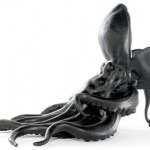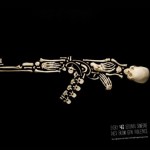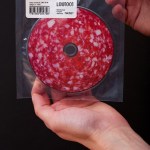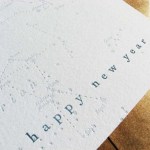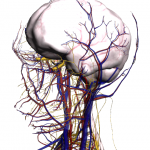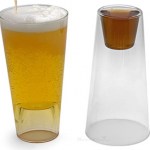design
While we're on the bioanimation topic, I recently heard from Jess at Nervous System, who sent me links to some animations of their new jewelry line, hyphae, "growing" in virtual space. Check it out:
Hyphae - growth of the Vessel Pendant from Nervous System on Vimeo.
They explain,
Hyphae is a collection of 3D printed artifacts constructed of rhizome-like networks. Inspired by the vein structures that carry fluids through organisms from the leaves of plants to our own circulatory systems, we created a simulation which uses physical growth principles to build sculptural, organic structures.…
Perhaps you have noticed that I haven't been blogging very much lately. Probably not, which is why I don't ever do these "sorry for not posting" posts, but I'm making an exception this time because it is a very special occasion. So, apologies for my recent lack of posts, but I got married last weekend! Of course, my wedding was not without biologically inspired design appropriate for mention on this blog. On my special day I wore Nervous System's algae inspired Filament Necklace.
Nervous System is a small and awesome company that combines background in biology, architecture, math, and…
So lately I've been trying to understand open source licensing options for software code, which is hard, because I'm not a coder. (If I don't understand an xkcd, it's almost always because it's some sort of Python joke.)
Anyway, Michael Ogawa made some videos a few years back depicting the growth of various projects (Python, Apache) as various developers came on board and committed code to the pool. His Python video is fascinating; it starts in 1991 with Guido van Rossum, who slowly attracts other developers. Through 2000, you can easily watch individual participants come in and out of the…
O designer-readers who like to work and play with Photoshop, this contest may be up your alley: Quirk Books, the outfit behind Pride and Prejudice and Zombies, has joined with Bridgeman Art Library to invite submissions for its "Art of the Mash-Up" competition. Basically, they want you to prove you can do better than the Regency unmentionable pictured above:
The iconic "Zombie Lady" on the cover of the New York Times Best Seller Pride and Prejudice and Zombies captured the imagination of readers around the world and has become one of the most recognizable book jackets in recent history.…
We've been buried under ice, snow, and slush up here in Massachusetts for months, and the chlorophyll deprivation is brutal. The other day I was chatting with someone, and he suddenly tuned out of our conversation, gazing into the distance wistfully. "Oh, sorry," he said, "I just noticed I can see some grass over there."
If only I'd known months ago about Colleen Jordan. Her tiny plant necklaces are little green reliquaries of summer, so you can always look down and see leaves - even in February in Boston.
Sadly, the necklaces (which are 3D-printed polymer and start at $55) don't come with…
Synthetic biologists work on designing living cells, but engineered bacteria don't usually come up when you think of "designer" things. This year however, a synthetic biology design is up for a Brit Insurance Design of the Year award, up against the Lanvin Spring collection, Angry Birds, and Rock Band 3! Designers Daisy Ginsberg and James King worked in collaboration with the 2009 Cambridge iGEM team (including awesome blogger Lab Rat) to imagine ways that people could use bacteria engineered to produce pigments in the future. Check out their video about the science and design of E. chromi:
Okay, I knew that planets are big, intellectually, but a well-done graphic is worth a thousand words, and a pretty HD video is even better. Brad Goodspeed made this video to suggest what other planets would look like, if they orbited Earth at the same distance as the Moon does. I've embedded it, but you should seriously watch it in HD, full-screen for maximum effect.
Scale from Brad Goodspeed on Vimeo.
I have nightmares like that. Seriously. But is the video accurate?
In addition to being full-on creepy, Brad's video produced a fascinating discussion in the comments and on various sites…
I think the Haptica, by David Chavez, is pretty awesome:
I've seen some criticisms that this watch is misguided, because you can already get affordable watches that speaks the time aloud. As far as I'm concerned, those criticisms miss the point (as does the Kickstarter video, somewhat, with its emphasis on the potential embarrassment factor of audible watches). This project acknowledges that to a blind person, reading Braille is not only less embarrassing, it's also faster, easier, and (for some) more dignified than being read to. It assumes the blind, like the sighted, deserve access to…
I think DNA is amazing. I think biotech inspires great design. And if you've read this blog at all, you know I love sciart. But I just cannot understand the new infogenetics product from DNA 11 - the company behind that trendy gel electrophoresis wall art. While I'd normally just say "I don't get it" and move on, DNA 11 claims that their "augmented art" is "the ultimate intersection of biology, art and technology." I don't know how that could get more squarely in the BioE wheelhouse. So let's take a closer look at how, exactly, biology and art intersect in the "Ancestry Portrait" (pictured…
Industrial food production separates us from our food, increasing the distance from living thing to food product. As factories continue to import corn and export almost everything we eat, writers like Michael Pollan urge us to eat "real" food, and projects like the Slow Food movement have gained over 100,000 members who strive to preserve traditional and regional ways of growing and cooking food. At the same time, a growing number of young contemporary artists also explore the distance between us and what we eat by bringing secretions of the human body into food production.
Human secretions…
An impressive short film, "Core," by animation group selfburning, via Fubiz. The music is lovely.
With The Symbiotic Household, Elliott P. Montgomery seeks to find answers to problems caused by climate change. Low-cost, low energy solutions are proposed through complex genetic engineering of domesticated insects--"What better way to deal with a future need than with a future technology?"
The project is deliberatively provocative; "By offering a problematic answer, I want to encourage viewers to question the entire scenario and thereby take part in the discussion." What do you think?
via we make money not art
Isis the Laboratory Goddess sent me a Buzzfeed link featuring this incredible anatomical gown:
The artist/seamstress deserves credit for what appears to be an incredibly elaborate embroidered stiff satin gown that, on different panels, depicts circulatory, skeletal, muscular and pulmonary systems. Wow. I can't figure out who made it, so if you know the original source, please email me the link so I can update the post with the creator's information Mystery solved! The photo is by miyake juin, from a Fashion Week event at Shih Chien University. The gown's designer is Chinese; I direct you to…
An unbelievable octopus chair - nay, throne - by Maximo Riera.
"the Octopus Chair places the animal and human being in harmony, where each is considered equal and one is not subject to the other. The octopus is not decoration; it is as intrinsic to the chair as the person sat upon it."
Via NotCot (there are even "making of" pictures!)
Want one? email info@maximoriera.com.
. . . from gun violence.
A new PSA campaign is based on artwork by artist Francois Robert. Via fubiz.
Unfortunately, the shift to digital music sales has largely eliminated the art of traditional album design - framing the music in cleverly designed sleeves and cases. The new Shidlas cd, "Saliami Postmodern," is a meaty exception. Yum:
Via Fubiz (the weirdest thing about the fubiz post is when they show the cd in a Discman. Who still has those?)
Design by Mother Eleganza.
. . . especially with these delicate, icy Orion constellation cards from Campbell Raw Press.
This series of sciart wallpapers by Dan Funderburgh were inspired by the Time-Life Science Library, a series of educational books published in the 1960s. For those of us old enough to remember them, Time-Life's series are objects of nostalgia in themselves. Coupling the vintage design and palettes of those books with vintage sci-art symbolism yields a sharply contemporary set of prints.
Funderburgh describes his work as "a repudiation of the fabricated schism between art and decoration;" you could also describe it as a repudiation of the fabricated gulf between science and design. (Fun…
Google Labs just released a new "experiment" - Body Browser. You have to upgrade to Google Chrome beta if you don't already have it, but when you do, you can play with a 3-D, rotatable reconstruction of a (female) human body. Sliders let you fade the circulatory, skeletal, muscular, and nervous systems in and out over the body organs; you can toggle labels on and off, and you can zoom, spin, and rotate in a way that would only be cooler if it were on a touchscreen iPad. (Yeah, that's what I said, Google. Do it!) Check out this screenshot:
Toggle a few sliders and you can wrap the vessels and…
I love creative design. Here begins a new theme on Omni Brain.
Do you only have a small cabinet and need to fit in as many drinking tools as possible? Do you want to get sticky booze all over your house? This is for you!
-via gizmodo-
